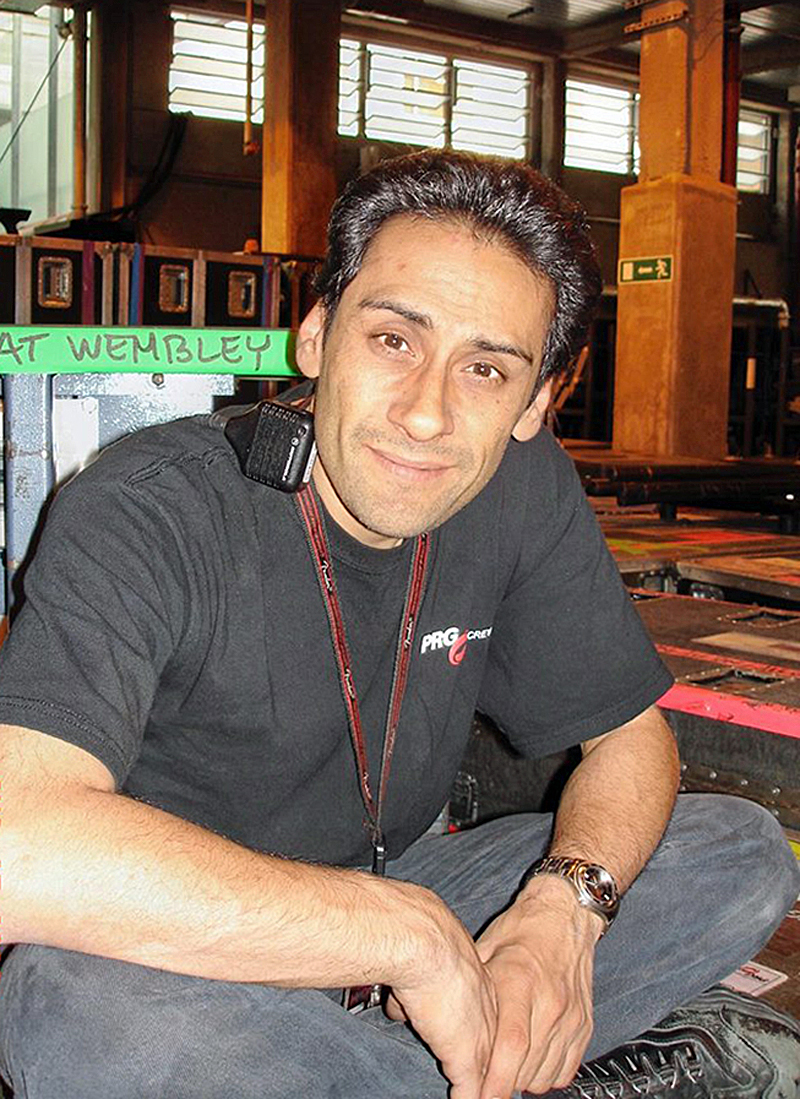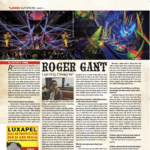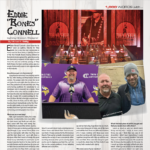
Jerry “Hodgie” Vierna is a lighting crew chief for concert touring and large events. He has traveled all over the world with a range of performers, including Poison, the Grateful Dead, Aerosmith, Madonna, Justin Timberlake and Roger Waters. During his career he has made the transition from massive PAR rigs to massive moving light rigs. Vierna still loves touring as well as mentoring the next generation of touring professionals.
How did you start out?
I started doing lighting in high school, then a few years down the road I discovered rock ‘n’ roll lighting. I went on the road in 1980 with a band that traveled the Northwest and ended up in Anchorage, Alaska. In Alaska, around 1982, I was working with a small lighting company that had the opportunity to buy a big lighting rig, for the freshly built Sullivan Arena in Anchorage. I got a hold of Peter Alexander at Tasco, down in Los Angeles, and he and I negotiated the deal. I started crew chiefing that rig with the Anchorage IATSE.
When I moved to Los Angeles in 1986, I went to work for Light and Sound Design;
Peter Alexander had gone over there and was instrumental in getting me hired. Working in the shop for a couple of years, I ended up being in charge of electronics, where I learned how to fix everything. They then sent me out — color changer guy, loader, moving light tech, truss builder, monkey climber — whatever was needed. About ‘89/’90, I was on the Poison Flesh & Blood tour. I started out as the camera guy and ended up the crew chief on that tour. That was my first crew chief job. In 1998, LSD got bought by PRG, and I’ve been with them ever since.
What was a standout project in your career that quickly comes to mind?
Project-managing the 1996 Olympics in Atlanta. I was a project manager for LSD and had many hats that year. I was actually on the Olympic Organizing Committee. We did the lighting design for Centennial Olympic Park. That was probably the largest lighting rig that I’ve ever assembled; it required 42 full 400A services. The city of Atlanta ended up building a sub-station on-site for us. It was huge — thousands of conventional fixtures and hundreds of moving light fixtures. It was two years of planning and two-and-a-half months to install it. It was an awesome project.
What’s the most insane job you recall doing?
Woodstock ‘94. I was the crew chief, and there were many, many, moments where we all thought, “This is just not going to happen.” The rain in ‘94 went on for days as we assembled a dozen trucks of lighting. It was a convergence of a Grateful Dead rig, a Red Hot Chili Peppers rig and a bunch of trucks from the shop, all being assembled and prepped right then and there in the field. That one was tough. We blew half the rig because a roof seam broke and dumped water onto stage left dimmer beach that was sunk down into the stage so that the monitor guy could see the performers. We ended up with about a foot of water in the dimmer pit. Everything blew up while we’re live to planet Earth — a band was onstage, MTV said there’s nine million people watching, and we had over 260,000 people in front of our stage. It was crazy, it was all about dealing with water on that one.
What were some milestones in your career?
I’ve had several. I’d say calling spots for Roger Waters: The Wall. Stage managing Madonna for two tours, site coordinating for Aerosmith, stage managing for Justin Timberlake on the FutureSex/LoveSounds show. Being the crew chief for the Grateful Dead for five years, the Olympics in Atlanta — lighting for Centennial Olympic Park, and project managing the AT&T Global Olympic Village. Being a lighting director for Jerry Garcia. Those are some. I have had the opportunity to do all different things. A few years ago, I had to come to terms with, “What do I want to be when I grow up.” To me, being a lighting crew chief is still exciting; it’s still challenging. Also, I am teaching a lot of people — I do everything possible to do that. I wrote a manual for PRG’s internship program of my standards of prepping — of tour etiquette, of why we do the things we do and how we do them. Mentoring, teaching and breaking down rigs is my path.
What do you enjoy most about your career?
I enjoy seeing the people who have worked for me on crews go on to their own jobs as chiefs and the like. I am proud to have been part of shaping someone’s career and sharing my knowledge from my years doing this. I’ve been to a couple of hundred countries, and I’ve stayed in a couple of thousand cities; I’ve had the opportunity to go to all these places, do all these great things, help so many people in their careers. I really am a very blessed person. I acknowledge that often.
Who have some of your mentors been? Who mentored you?
Peter Alexander at Tasco and LSD; Dak Harris had a lot of influence on what I do; and Pete Currier was a crew chief and is now a rigger in the U.K. These are people that had a great deal of influence on my touring career and at teaching me the ropes.
Is there a piece of advice you got early in your career that you still find applicable today?
“Love what you do!” And, “Get out of there if you don’t like it.” Life’s too short to not like what you do. It’s really, really basic, and yet some people get trapped into having to do something they don’t like. Luckily for me, I love what I do and I respect the people I work with and who employ me. It’s all about people and how you treat them. How you manage yourself going into a venue, how you treat the people in the venue, how you come off as a team — or not. Most of what I do is people management, and teamwork is everything.
What’s a piece of advice you would give somebody looking at touring?
Learn to get along. You’re going to go on tour with a bunch of people, and if you’re a very, very particular, picky person, you need to lose that or you’re not going to survive.
What surprised you about your career path?
Just that I got to go out and make money at it. I started out in theater. I never knew that it would be a big business and I would be traveling all over the world. I was just lucky enough to be one of those people that figured out, in high school, what I really loved to do. Luckily, preparation met opportunity, and I’ve managed to turn that into something that pays the rent.


